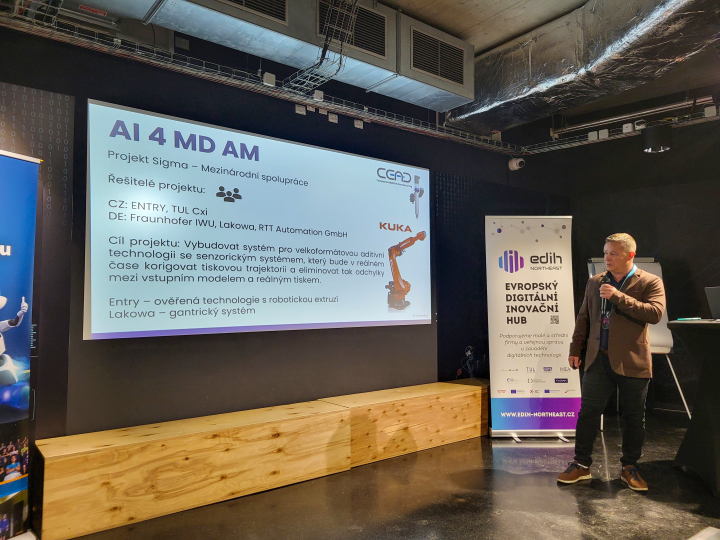The future of large format printing: moulds that think for themselves
23. 6. 2025
AI4MultiDirectAM: Printing That Thinks
“When strong academic foundations meet the technical boldness of companies, solutions emerge that individual players might take years to discover. International projects are what accelerate the journey from lab to production.”
Adam Blažek, project team member

Adaptive Multi-Directional 3D Printing Powered by AI in the Czech-German AI4MultiDirectAM Project
Composite part molds are usually cut from blocks, milled, fine-tuned, and fixed. It takes weeks. But what if they could be printed in a matter of days – with no defects, no waste, and no supervision?
This question didn’t arise as an academic hypothesis. It was a need. At Entry Engineering in Liberec, molds for composite parts – like car bodies or technical covers – are made regularly. But traditional manufacturing is expensive, slow, and hard to tweak on the fly.
That’s why, in cooperation with the Technical University of Liberec, Fraunhofer Institute, and other partners, a project was launched with a simple goal: to print molds in a way that makes sense. Fast, without costly maintenance, with flexible shape or material changes. And most importantly – so the system itself knows when something’s wrong and adapts.

How Does It Work?
The core is a large-format 3D printer built on a 6-axis robot that uses a screw extruder to lay plastic in layers. While standard printers stack vertically and mostly handle boxes, this one prints in multiple directions – along curves, at angles, based on part load and shape.
This demands precision, repeatability, and countless real-time decisions. That’s why it’s not run by a simple program but by artificial intelligence. It learns from data collected by thermal cameras, LIDAR, and other sensors monitoring the printing process. If anything is off – layer width, temperature, deformation – the AI suggests a change. And that change is immediately reflected in the next layer. No waiting for operators, no overheating, no reruns.

Why This Isn’t "Just Another 3D Printer"
It’s not just about a machine. It’s an entire system that:
- runs autonomously,
- collects and analyzes data,
- learns from past errors,
- and proposes corrections before problems affect the outcome.
It prints from plastic granules. The extruder handles over 20 kilograms per hour. Material goes straight into the mold – no leftovers. And the entire print task is recorded as a digital twin – including all interventions and deviations.
That’s a big step up from just watching your print via webcam, hoping the corner doesn’t peel off.
Who’s Behind It
- Entry Engineering builds and tests the whole robotic system – in-house, for real-world projects.
- TUL (CXI) develops the AI models, processes data, and fine-tunes communication between sensors, robot, and control system.
- Fraunhofer IWU provides a testing environment and experience with industrial printing.
- RTT Automation contributes sensor expertise, Lakowa verifies functionality in plastic parts production for ambulances and trains.
The team is diverse. Some focus on sensor selection, others tune databases or train neural networks. But they all share one goal – connecting industrial practice with intelligent, autonomous manufacturing control.
What’s the Outcome?
Entry Engineering currently produces about 20 molds per year. With this new technology, they aim to more than double that – faster and cheaper.
But the goal isn’t just to meet their own needs. The print facility will be open for external orders – in interior design, architecture, or aerospace. Molds that used to take three weeks will be done in five days.
Material waste will also drop by up to 90%. And every print will have a "memory": a stored data log that tells you exactly what happened, when, and why.
“This isn’t just a tech demo. It’s real proof that connecting industry and research across borders can build a system that’s smart, flexible, and ready for the future of manufacturing,” says Adam Blažek, project team member.

Printing That Thinks
No, the printer doesn’t have a soul. But a system that understands what it’s doing – and why it might be doing it wrong – is a huge leap. Whether in automotive, aerospace, or any workshop where precision, time, and repeatability matter.
The AI4MultiDirectAM project runs until 2027, but it’s already shaping a technology that won’t need constant supervision. It will just work. Smartly. And efficiently.





.jpeg)

.jpeg)
.png)


.jpeg)
.png)
.png)
